|
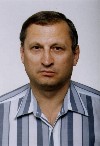 In order to understand the nature of the Foreign Exchange Certificates (further FX) one must take into account that the USSR was the country of overwhelming state property and total control of the state over the lives of its citizens. The state was the only employer. Since the creation of the Soviet system in 1917 there were different stages of its development. Here the period roughly from 1961 to 1991 is under consideration. Before 1961 the links with the rest of the world were so limited that there was no need to create a "barrier" between the Soviet Rubles and foreign currencies. At the beginning of the
1960's the Soviet Union was painfully opening to the world and active cooperation, especially technical, started not only with the socialist, but also with the new emerged states in Africa and Asia. More and more Soviet technicians went abroad to work. How were they to be paid when it was not desirable by the Soviet system for its citizens to possess or use foreign currency? In order to understand the nature of the Foreign Exchange Certificates (further FX) one must take into account that the USSR was the country of overwhelming state property and total control of the state over the lives of its citizens. The state was the only employer. Since the creation of the Soviet system in 1917 there were different stages of its development. Here the period roughly from 1961 to 1991 is under consideration. Before 1961 the links with the rest of the world were so limited that there was no need to create a "barrier" between the Soviet Rubles and foreign currencies. At the beginning of the
1960's the Soviet Union was painfully opening to the world and active cooperation, especially technical, started not only with the socialist, but also with the new emerged states in Africa and Asia. More and more Soviet technicians went abroad to work. How were they to be paid when it was not desirable by the Soviet system for its citizens to possess or use foreign currency?
There were the following categories of people who could potentially receive foreign currency:
· Civil technicians working abroad.
· Military working or serving abroad.
· Diplomats and their families working abroad.
· Writers, composers, painters, etc. receiving currency fees thru the ALL UNION COMPANY based on authors' rights.
· Inventors receiving currency fees thru the State Committee of the USSR for inventions and discoveries.
· Transport workers, seamen and sailors returning from abroad.
· Persons receiving private transfers from abroad.
It is quite natural that the first category was the most numerous. We must not also forget that a considerable part (if not more than 50%) of the Soviets worked abroad by
agreements of technical assistance i.e. paid by the USSR itself. In this framework, at the beginning of the
1960's, the state created the ALL UNION COMPANY "VNESHPOSYLTORG"(VPT). The aim of this large state trading company was to buy
western goods for hard currency abroad and sell them at a chain of specialized "Beriozka" shops. Quality Soviet goods represented an insignificant part. At the same time, for dealing with external trade, the "Bank for Foreign Trade of the USSR" (VneshTorgBank) was set up. In this bank all people receiving money from abroad were required to open accounts and deposit the money they received in foreign currency Rubles (Invaliutnyi Rubles). From this account they could then take their money out as needed in the form of the below mentioned Vneshposyltorg Certificates. It was not until the beginning of the
1980's that Soviet citizens were allowed, if they traveled abroad, to withdraw foreign currency (mainly US dollars). It should be stressed that Invaliutnyi Rubles accounts were not allowed for the military up to the end of the USSR. They could receive only cash VPT money, except for high-ranking officials. Since the very beginning the state differentiated the accounts by the
type of currency that was on deposited. The people did not earn dollars in socialist countries.
In 1988 the bank "VneshTorgBank" was renamed the "Bank for External Economic Activity of the USSR" (VneshEkonomBank). So this system was organized in order to prevent the payment of foreign currency and to make the people spend their earnings at home rather than abroad. Currency substitute - VNESHPOSYLTORG (VPT) Certificates were introduced simultaneously with the shops opening in 1965. Such Certificates are often called VPT Certificates or "Foreign Exchange Certificates" (FX) in
western terminology. It is exactly these Certificates that were used in these shops. The VPT Certificates were issued in the same currency denominations as the Soviet Rubles (from 1 Kopek to 100 Rubles) as well as the rarely seen certificate of 250 Rubles
(Fig 1, 10 Rubles, VPT Certificate,
1966) and (Fig. 2, 20 Rubles, VPT Certificate,
1968).
From the very beginning there were three types of Certificates:
· Blue stripe (across) paid from the accounts of the persons having worked in socialist nations.
· Yellow stripe (across) paid from the accounts of the persons having worked in developing nations.
· Certificates without stripe paid from the accounts of the persons having worked in or having received payments from capitalist nations.
The VPT Certificates were issued dated 1965, 1966, 1967, 1968 (year not listed in Ryabchenko catalogue and reportedly issued only in higher denomination from
1 Ruble) and 1972. Obviously, the Certificates without stripe were received by the Soviet diplomats working in the
western countries and by the people who received payment from a capitalist nation. Formally the Certificates were equal in value but there were two peculiar features of their use:
1) Particular goods were sold ONLY for the Certificates without stripe.
2) There was a list of the goods sold in the Beriozka shops for full value if paid by the Certificates with blue stripe and with a discount if paid by the Certificates with yellow stripe or without stripe.
For this reason the Certificates were rated differently in the flourishing black market. Finally, the VPT Certificates were superseded by the VPT Checks in 1976 in the ratio of:
· 1 Ruble VPT Certificate without stripe for 1 Ruble VPT Check
· 3.6-3.8 Rubles VPT Certificate with yellow stripe for 1 Ruble VPT
Check
· 4.6 Rubles VPT Certificate with blue stripe for 1 Ruble VPT Check
MILITARY ISSUES
The VPT Checks dated 1976 were also issued in the same denomination as the Soviet Rubles from 1 Kopek to 100 Rubles)
(Fig. 3 - 1 VPT Kopek,
1976, Fig. 4 - 500 Rubles VPT,
1977). In addition, new notes of 250 and 500 Rubles (the only one dated 1977) were issued. On buying something in the shop these two notes were immediately cancelled by making a triangle cut in the lower part.
There was no strict rules for this procedure but it was seen to have been done many times. The black market value of the VPT
Checks varied from 1.5 to 2.2 Soviet Rubles for one Check. The way to a Beriozka shop was full of persons offering to buy VPT currency. Nearly all of them were just crooks trying to deceive you. They knew you would never complain officially - selling and buying VPT currency was a serious offence punishable by the Criminal code
with imprisonment (Article 88 in the Russian SFSR and article 80 in the Ukrainian SSR, the Criminal codes of Russia and Ukraine being slightly different at the time).
In late 1980's the Vneshposyltorg issued new Checks in the same denominations with red strips along the top and lower edges with the text "Special, for Military Trade"
(Fig. 5 - Military 100 Rubles VPT
Check). Such
Checks were reportedly used by the Soviet military in Afghanistan. This issue needs further study. The dream of many Soviet men - a brand new car of Soviet making - a Lada or a Volga- could easily be had, if you legally had VPT money or were ready to pay twice as much for it in the Soviet Rubles,
while facing all kinds of crooks on your way. On both VPT Certificates and Checks there might be round or triangle stamps nearly always on the face indicating the entity and place of issue. No official obligatory system seems to have existed regarding stamping. It should be underscored that the VPT Certificates of 1965, 66, 67, 68 often have stamping on the back "Certificates are Not For Sale". And the VPT Certificates of 1972 have
this text preprinted.
In many cases Certificates or Checks were paid at the bookkeeping offices abroad, especially to the military. There were sometimes problems with the foreign customs due to
this method. In December 1991 the VPT
Checks became useless and the accounts in the Bank for External Economic Activities were frozen for approximately one year. The people with VPT cash money on hand could deposit them back to the account (risky with the accounts frozen, but what was one to do?) or exchange them for Soviet/Russian Rubles at 1-1 ratio which were rapidly losing
value. However; if you earned the VPT money in a socialist country, like Mongolia, you had no choice and could only exchange them into Rubles. It should be also noted that there were no cases reported of identity control in the VPT shops. It is also interesting that thru VPT offices in Moscow the citizens possessing currency accounts could buy apartments in apartment building cooperatives, if they were entitled to get a new apartment and were officially in the queue
locally, garages if they had cars and putiovki (vouchers) for sanatoriums and rest homes in the most prestigious places (NOT ABROAD!) if recommended by the doctor.
One cannot help mentioning that the right to buy goods in the VPT shops did not have anything to do whatsoever with the
privileges in the society for the Communist party members and functionaries. The principle consisted
only in those having foreign currency accounts. However, it should be stated that mainly communist party members were sent abroad, as they were considered more politically and morally reliable because the 'SYSTEM" had additional means of control over the members of the CP. In other words the Certificates (Checks) were not solely for members of the Communist Party and were used for all citizens working abroad and earning money there. It should be also noted that the Vneshposyltorg system also included a chain of "Beriozka" shops where the goods were sold for hard currency only with the prices expressed in Invaliutnyi Rubles. They were intended exclusively for foreign tourists. Although sometime in the middle of the
1980's people working abroad thru different procedures gained access to their hard currency in the banks. The plain clothes security staff strictly controlled the people spending hard currency in the Beriozka shops if they appeared not to be foreigners.
TEAR CHECKS
Tear Checks issued in the period 1961 to 1989 can be divided into three large groups:
· Tear Checks for tourists
· Tear Checks Series "A" for seamen
· Tear Checks Series "D" for diplomats
TOURIST TEAR CHECKS (or CRUISE TEAR CHECKS) were used only to pay for the services and goods on board a ship (mostly), plane or train by the Soviet tourists or travelers. When traveling abroad a Soviet tourist had the right to export 30 Soviet Rubles with an obligation to return with them (unless exchanged against the Tear Checks) and with NO RIGHT to lose. The extra money was deposited at a Soviet bank available at all crossings. Before boarding the ship (plane, train) or on it the tourist could exchange the Rubles into a Tear Check to buy something at the convenience shop (called in Russian "bufet"), alcoholic drinks and cigarettes constituting the bulk of the goods. Just for information - Soviet tourists were entitled to exchange 50 Rubles into the foreign currency (thus receiving 50-60 Dollars) spent mainly for
western consumer goods.
Such Tear Checks varying slightly in design and texts may be undated (apparently late 1950's, or 1960) or with various dates 1961 through 1989
(Fig. 6 - Tear Check for 50 Kopeks,
1961). Their actual circulation was limited by the duration of one trip. The Checks were denominated in the Soviet currency from 1 Kopek to 25 Rubles (
from late 1970's the 1 and 2 Kopeks denominations were dropped and the 10 Rubles and 25 Rubles added) and issued in booklets containing various combinations of notes. So strictly speaking these Tear Checks, although state issued, do not belong to Foreign Exchange Certificates as they did not have any foreign currency
backing. It should be also noted that foreign tourists in the USSR could buy what they needed at the Beriozka shops directly for foreign currency or exchange their currency into Soviet Rubles at the official rate.
SEAMEN TEAR CHECKS, Series "A" were given for the unspent part of salary in foreign currency to the Soviet staff on different ships (including fishermen) on return home. They were issued with various dates between 1963 and 1989
(Fig. 7 - Tear Check for 10 Kopeks,
1980) having slightly different design and texts. The Checks in question were denominated in the Soviet currency from 1 Kopek to 25 Rubles (from late 1970's the 1 and 2 Kopek denominations were dropped and 10 Rubles and 25 Rubles added) and issued in booklets containing various combinations of notes just like the above tourist Tear Checks.
There are two most important varieties - with anchor and without anchor on them. It is curious that in 1974 both were issued! Unfortunately, the reason why two types were issued is not known.
These Tear Checks known as "bony or morskie bony " were used in the special shops (very often called Albatros, in Odessa such a shop was colloquially called
TORGSIN.) located in big port cities where one could buy goods including foodstuff inaccessible to ordinary Soviet citizens. Therefore, they were highly rated at the black market (roughly 1 to 10-15 depending on the actual availability of goods!). The prices in such shops were fixed in Invaliutnyi Rubles - you paid with the Tear Checks the sum written on the
label and there was no need for calculations.
It is, however, known that the "A" type Tear Checks were converted back into hard currency in 1992 for the employees of the sea and fishing companies (ONLY based in RUSSIA) provided they had corresponding records in the bookkeeping department. All illegally possessed Tear Checks were lost. The issues of some years are known for the collectors in booklets coming principally from the archives of sea companies due to the collapse of the USSR. At the time they did not have any currency or goods behind them. Apparently all these Tear Checks had validity up to 1991 no matter the year of issue, but this is not known for sure. At least during discussions with people who had used them, no one could recall there being any constraints on when they had to be used by nor problems in using older Tear Checks that had been replaced by newer dates/types. It is not known; however, why the state issued them in such a variety of years and design features. Although the 1980's show the period of stability.
It is worth while mentioning that the standard monthly salary for a Soviet seaman was slightly less than 30 Invaliutnyi (currency) Rubles i.e from 35 to 55 dollars depending on the rate (the rate in 1975 and 1990 was quite different). Actually the dollar equivalent was valid if the ship went to a capitalist nation or a particular seaman did particular work (not forseen by prescribed duties) saving thus currency for the state. If one went to a socialist nation or from one Soviet port to the other e.g. Odessa to Leningrad ONLY Series A Tear Checks were paid - no dollars.
DIPLOMATIC TEAR CHECKS, Series "D" were reported to be paid to the staff of the Soviet embassies abroad. The Checks were reportedly used in the VPT Beriozka shops selling for hard currency. These Tear Checks were issued with various dates between 1965 and 1989
(Fig. 8 - Tear Check for 2 Rubles,
1979) (the 1989 year is not reported in Ryabchenko). The Checks under consideration were denominated in the Soviet currency from 1 Kopek to 25 Rubles (from late 1970's the 1 and 2 Kopek denominations were dropped and 10 Rubles and 25 Rubles added). The booklets contained various combinations of notes just like the other Tear Checks.
All Tear Checks were watermarked and issued first in the name of the State Bank, then of the Bank for External Trade of the USSR and at the final stage (since 1988) of the Bank for External Economic Activities of the USSR. So all the Tear Checks in contrast to the VPT Certificates and Checks were not the money of multiple use. Now all these Certificates and Checks belong to history and on the territory of the former USSR one can buy anything for plain national money.
I would you to express my sincere thank to JOHN TRICK for all the help he has provided me in writing this article.
Bibliography
1. Ryabchenko P.F. Complete Catalogue of Paper Banknotes and Bills of Russia, USSR, CIS countries (1769-1994), Kiev, 1995, pages 587-595
2. L.Kats and V. Malyshev, Encyclopedia of Russian Paper Money, Volume 1, Governmental Issues 1769-1995, St. Petersburg, 1998, pp with listing 32, 33, 36, 37, 38 pp.with illustrations 201, 203, 204, 207, 208
3. Paramonov O. V, The Money of Beriozkas, "RODINA" - Russian Historical Journal for April 1999, pp. 74-75
4. Paramonov O. V, Order for Terminating Operations with the Series"A" Neshekonombank Checks, Newsletter "Tagansky Bonist", Issue 18 for November 1996 |
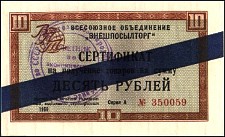
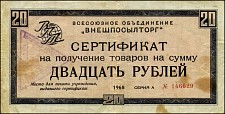
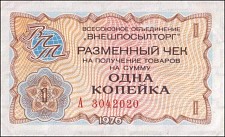
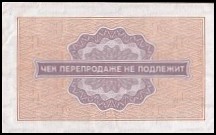
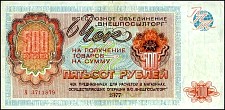
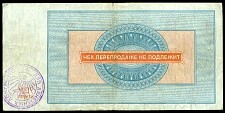
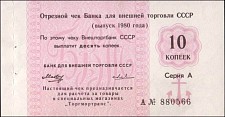
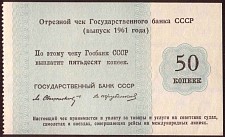
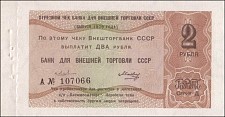
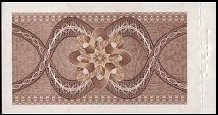
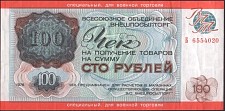
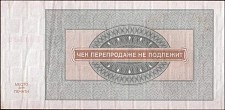
![]()